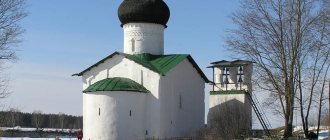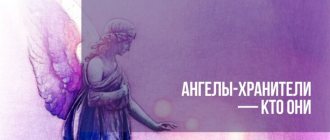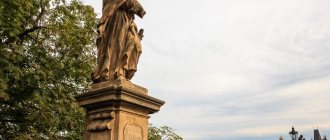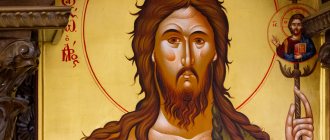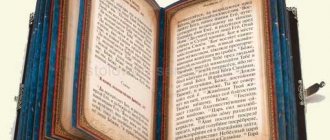Saint Simeon the God-Receiver is a pious righteous man, a resident of Jerusalem. Simeon is mentioned in the Gospel of Luke.
“The power of the Spirit of God was raised up on the day of the elder to come to the church, and when he saw the parent of the Child Jesus, do unto him according to the lawful custom concerning Him, and when he saw the Child, he knew by the Spirit that this is the promised Savior of the world, Christ, and cried out to God, rejoicing. : Alleluia"
— lines from the akathist to Saint Simeon the God-Receiver.
Saint Simeon the God-Receiver is found in the Gospel of Luke. Photo: k-istine.ru
Righteous Simeon was invited to the Alexandria Library by King Ptolemy
The Apostle Luke gives very little information about Simeon. Saint Simeon learned that he would not die until the promised Messiah came to the world. He waited a long time for the day to come when he would see Him. Meanwhile, the Egyptian king Ptolemy II wanted to fill his Alexandrian library with the texts of the sacred books. It was the most famous library at that time.
Then the king decided to invite all the scribes from Jerusalem. The Sanhedrin decided to send its wise men to Jerusalem. Among these scribes who arrived to translate was the righteous Simeon.
Simeon then began to translate the book of the prophet Isaiah. When he read the words:
“...Behold, the Virgin is with child and will give birth to a Son”
(Isa.7:14)
then I decided that the word Virgo was written here by mistake, along with the word Wife. Then he decided to correct this text. At the same moment, an Angel of the Lord appeared to Saint Simeon, restrained his hand from what was written and said:
“...Have faith in the written words, you yourself will be convinced that they will be fulfilled, for you will not taste death until you see Christ the Lord, who will be born of the Pure and Immaculate Virgin.”
It was from that very day that Elder Simeon began to expect the coming of the Messiah.
In the photo we see the very moment when Saint Simeon the God-Receiver wanted to correct the word in the book of the prophet Isaiah, but the holy Angel of the Lord stopped him, saying that everything that is written will all be fulfilled. Photo: icons.pstgu.ru
God from a book
“On the feast of Candlemas, we remember how Elder Simeon met the living God. Today we have a lot of knowledge “about God” - books, commentaries on how to live as a Christian. And a subtle substitution arises: you read books “about God”, and it seems that you have “met”. What to do with this gap between the “god from the book” and the God whom Simeon met?
—What does the reader himself look for in a book? Guide to action or “do it for me spiritually”? Knowledge from a book - like the grain in the Gospel parable of the Sower - dries up if there is no nutrient medium - experience, action.
Books read incorrectly can become ersatz. As an ersatz of something, they in some way quench the thirst for knowledge, and at some point the feeling of internal hunger is dulled.
But this only gives a semblance of saturation, and therefore there is a feeling of substitution, self-deception. If, without practicing the first, I take up the second, third, fifth, then my entire experience of “God” remains exclusively fantasy and speculation and only distances me from the meeting.
Sometimes the thirst for knowledge “through reading” paradoxically testifies not to the search for God, but to the closure of the question of God.
I am ready to read “about God” and admire. In some places I’m not ready to humble myself, but in others, on the contrary, to dare, but I’m just not ready to pray - I don’t have time. And if I read it, it’s like I “did” something, acquired a certain portion of spirituality and am free, the gestalt is closed.
And it is not a fact that this problem is somehow systematically recognized by people.
Simeon the God-Receiver met the Mother of God and Joseph the Betrothed in the Temple of Jerusalem
One day Simeon came to the temple in Jerusalem. The Gospel of Luke says that he came there not just by chance, but by the inspiration of the Holy Spirit. He called him to come on this day, to this place.
This happened on the very day when the Virgin Mary and the Betrothed Joseph came there. They came there to perform a ritual that is necessary according to Jewish law, that is, to appear before the Lord of their Divine Firstborn and make the prescribed sacrifice.
Saint Simeon holds the Messiah - Jesus Christ in his arms, when the Mother of God and Joseph the Betrothed brought him to the temple in order to appear before the Lord of his Divine Firstborn and make the prescribed sacrifice. Photo: ikonavdom.ru
As soon as Simeon saw the Mother of God with the Baby in her arms, the Holy Spirit immediately revealed to him that this Baby was the very Messiah whom he had been waiting for so long. Then Elder Simeon took the Baby in his arms and said these prophetic words:
“...Now, O Master, you are releasing Your servant in peace, according to Your word, for my eyes have seen Your salvation, which You have prepared before the face of all people. Light for the enlightenment of the Gentiles and the glory of Your people Israel."
When Saint Simeon saw the Infant Jesus Christ, the Holy Spirit told him that the Infant was the very Messiah for whom he was waiting.
Photo: xn--b1algoccq.xn--p1ai When he blessed the Mother of God and Joseph the Betrothed, he addressed the Mother of God with these words:
“...Behold, this One is set for the fall and the uprising of many in Israel and as a subject of controversy, and a weapon will pierce Your own soul, so that the thoughts of many hearts may be revealed.”
(Luke 2:22-35)
This holiday in the Russian Orthodox Church is called Presentation. The Presentation of the Lord is celebrated on February 15th.
The Presentation of the Lord is one of the most ancient holidays of the Orthodox Church.
Evangelist Luke also reports:
“...There was also Anna the prophetess, daughter of Phanuel, from the tribe of Asher, who had reached a very old age, having lived with her husband for seven years from her virginity, a widow of eighty-four years old, who did not leave the temple, serving God day and night with fasting and prayer. And at that time she came up and glorified the Lord and prophesied about Him to all who were waiting for deliverance in Jerusalem.”
(Luke 2:36-38)
Liturgical use
The prayer of Simeon the God-Receiver is mentioned among the vespers in the Apostolic Constitutions (7:48), dating back to the end of the 4th century. In the books of hours of the 8th century, it is already mentioned as part of Vespers, and its place in this order of rites (between the stichera and “Holy God”) has been preserved in the Orthodox Church to the present day. For Catholics, it is one of the main biblical songs, sung at Compline with an antiphon (“Save us”). The Church of England, which does not have Compline, uses this song at Vespers.
In the Orthodox Church, the Typikon indicates that the song of Simeon the God-Receiver is not sung during worship, but read. The hymn, according to the liturgical instructions, is “said by the rector,” and the following Trisagion according to the Our Father is read by the reader (at weekday vespers, the Typikon allows the reader to read the hymn). But, despite the instructions of the Typikon, in the Russian Orthodox Church it is most often sung. It is read only during Lent on those days when the liturgy is not supposed to be performed (usually Monday, Tuesday and Thursday), and also as part of the “Prayers of Thanksgiving for Holy Communion” at the end of the liturgy.
The Song of Simeon the God-Receiver is also read in the Orthodox Church during the baptism of male infants during their churching, that is, when bringing the baby into the altar and carrying him around the throne through the high place.
In the Catholic Church, the Song of Simeon the God-Receiver is also sung during the procession with candles on the day of the Feast of the Presentation.
An icon was painted to Saint Simeon
An icon was painted to Saint Simeon. The icon of Simeon contains his image with a long gray beard. He is dressed in monastic robes. In his arms he holds the Infant God. In his right hand he holds a parchment with the words of God. Sometimes on the icon Saint Simeon is depicted with Anna the Prophetess.
This is what the icon of St. Simeon the God-Receiver looks like. Photo: xn--80ancrr3a.xn--p1ai
Relics of the Prophet
As already mentioned, Saint Simeon lived 360 years. There is no exact information about the place of his burial. In Jerusalem, they point to a grave pit in one of the aisles of the Greek church as a possible burial place of the saint. According to other sources, Simeon the God-Receiver was killed during the massacre of the infants, when the king's guards
Herod was interrogated, trying to find out about the whereabouts of Jesus. According to apocryphal legends, after the resurrection of Christ, Simeon, like other righteous people, was resurrected to eternal life.
In the sixth century, his relics were transferred to Constantinople to the Chalcopratian Temple, located at the Copper Gate of the capital of Byzantium. About the veneration of his tomb in 1200. reports Saint Anthony of Novgorod, who made a pilgrimage to the Holy Land.
Currently, in the German city of Aachen, the right hand (right hand) of the saint is kept in a special reliquary casket. You can venerate the shrine only once every seven years, when it is put on display for pilgrims.
The reliquary, made by skilled ancient craftsmen, is a small casket decorated with precious stones, with sculptures of the Virgin Mary and St. Simeon receiving the baby Savior into his hands.
The relics themselves appeared in 1243 in the Croatian city of Zara (Zadar), where they are located in a special sarcophagus in the Church of St. Simeon.
Troparion and kontakion written to Saint Simeon
On the day of the celebration of Simeon the God-Receiver, the troparion and kontakion are sung in the church. On the day of the holiday, if you come to the temple, you can hear them. These chants can also be sung at home in front of the icon of the saint.
Troparion, tone 4:
Simeon the Elder is rejoicing today; he has taken the Infant of the Eternal God into his hand, asking to be released from the bonds of the flesh and crying out: my eyes have seen Your worldly salvation.
Kontakion, tone 4:
The elder today renounces the bondage of praying to this corruptible life; they will accept Christ into their arms, the Creator and Lord.
Prayers written to Simeon the God-Receiver
There are prayers written for Saint Simeon that can be read at home in front of his icon. You can always address the saint in your simple words. The most important thing is that your prayers come from the heart and are sincere. Only the most sincere words will be heard.
One of the varieties of icons of St. Simeon the God-Receiver
First prayer to Simeon the God-Receiver
O great servant of God and God-receiving Simeon! Look at me, a sinner, who falls to your holy icon and asks for your intercession and help: for sorrow will keep me from the troubles and evils that are present to me now, and I have no consolation for my much-pained soul. Looking for help from people, and not finding it.
I cried out to the Lord, and did not hear me, but I angered His most pure goodness with my iniquities, and with the multitude of my many sins, His philanthropic womb was bitter. And who will help me now? who will satisfy my sorrow; who will give joy and tranquility to my troubled soul?
To you, great servant of God, I come running, sinful and unworthy, knowing that you have great boldness in Christ God and that you are a powerful intercessor for all who come running to you with faith and demand your intercession and help.
Pray to the Lord, the Lover of Mankind, that having forgiven me my countless sins, He will not turn His mercy away from me, but because He is good and compassionate, He will show me His endless mercy, and in the cruel misfortunes and misfortunes of my embitterment He will give me His omnipotent help, and to my distressed soul my weakness, peace, strengthening, consolation and tranquility bestows.
To her, great servant of God, lift up your God-bearing hand to those who will be carried in your arms by the will of Christ our God and pray to His goodness, so that He will not reject the prayer of my heart for my unworthiness for my sake, but will show me His mercy in due time, to the glory of His endless bounty and powerful intercession yours, for whom all glory and thanksgiving are due to Him, together with the Father and His Most Holy Spirit, now and ever and unto ages of ages. Amen.
Second prayer to Simeon the God-Receiver:
O God-receiving Simeon! Hear us, sinful servants of God (names), and do not take away your holy protection from us, pray for the goodness of the Lord, so that He may turn away His anger from us, righteously moving towards us according to our deeds, and, despising our countless sins, turn us on the path repentance and will establish us on the path of His commandments.
Protect our life in peace with your prayers and ask for good haste in all good things, granting us everything we need for life and piety, so that we may live a quiet and silent life in all piety and purity, and thus we will achieve eternal peace, where we will be worthy of the Heavenly Kingdom of Christ God ours, to Him is all glory due, with the Father and His Most Holy Spirit, now and ever and unto ages of ages. Amen.
They also pray to Simeon the God-Receiver for children, especially for their health. The third prayer is just read for the children. You can read it at any time in front of the icon of St. Simeon.
Third prayer to Saint Simeon the God-Receiver:
Oh, great servant of God, God-receptive Simeon! Standing before the Throne of the Great King and our God Jesus Christ, we have great boldness in approaching Him, in our arms, for the sake of salvation, we will rush to the one who wills. To you, as a powerful intercessor and a strong prayer book for us, we, sinners and unworthy, resort.
Pray for His Goodness, for He may turn away His anger from us, righteously moved towards us by our deeds, and, despising our countless sins, turn us to the path of repentance and establish us on the path of His commandments.
Protect our life in peace with your prayers, and ask for good haste in all good things, granting us everything we need for life and piety. Just as in ancient times Great Novograd, by the appearance of your miraculous icon, delivered us from the destruction of mortals, so now we and all the cities and villages of our country have been delivered from all misfortunes and misfortunes and vain deaths by your intercession, and from all enemies, visible and invisible, with your protection.
Let us live a quiet and silent life in all piety and purity, and, having passed this temporary life in the world, we will achieve eternal peace, where we will be made worthy of the Heavenly Kingdom of Christ our God. To Him all glory is due, together with the Father and His Most Holy Spirit, now and ever and unto ages of ages. Amen
By leaving a comment, you accept the user agreement
Here is what they wrote about the elder in the Moscow Church Gazette in 1902:
In the old abolished cemetery, located near the former wooden church, a parishioner known for his strictly pious life, a peasant of the village of Skokovo, Simeon Ivanov, or by his popular name - “Semyonushka”, was buried. The information about his life is very brief, drawn from the church chronicle of 1868, and from popular memory, quite clearly depicting him as a true Christian, an obedient son of the Church and a strictly pious person.
Simeon Ivanov was born, as can be concluded from the confessional books and metric record of his death in 1748. He got married in his twenties, and at the beginning of the 1800s he was already a widow. In the examined books of 1806, he is listed as a widow, 61 years old, and has a son aged 40 and grandchildren. It is unknown at what time he took upon himself the difficult feat of foolishness. Always, at all times, he walked barefoot, in a long white linen shirt with his head open, and did not feel the cold.
His life was spent in work, prayer, fasting and love for his neighbors. Not liking being idle, he was always busy with some kind of work or helping the peasants in their work, for example, crumpling flax, pinching wool, etc. From an early age, he was constantly present at divine services - on Sundays and holidays in his parish church , and on weekdays he went to the Savvin Monastery. At the same time, he was a strict faster and abstainer. On Wednesdays and Fridays I did not eat any food, and during some fasts I did not eat anything for several days in a row. He did not take any hot drinks and did not eat meat. He kept his words pure: no one heard swear words from him. He didn’t know how to read, but he was distinguished by his intelligence and memory. On holidays, he loved to walk from house to house in the village and tell the peasants who was celebrating their birthday, when, and when their livestock would increase, thus warning housewives against the danger of freezing new livestock fruit in the winter. This expressed his love for the people.
But he had a special love for children. Semyon Ivanov loved to be with small children, comforting them with various games and conversations. But he tried to hide his activities with children from adults and immediately left the children and walked away when anyone approached him to see games or hear conversations. About his death in a copy of the registry book for 1812, stored in the archives of the church in the village of Ershovo, in the month of July under No. 10 it is written: “10 the peasant Semeon Ivanov, who was 67 years old, died as a Christian in repentance in the village of Skokov, was buried On the 11th day, priest Andrei Ivanov performed the burial at the church.” The grave of the deceased is held in great esteem, in the summer it is decorated with flowers, on it lies a stone with an already worn-out inscription and there is a cross with a small icon of the holy righteous Simeon the God-Receiver.
Almost 90 years have passed since the death of the servant of God Simeon, but the memory of his truly Christian and pious life has not been erased and is still preserved and honored among the inhabitants of not only the surrounding villages, but also very distant ones. Many come from afar to the grave and ask local parishioners to perform a memorial service for the repose of the soul of the deceased. Parents with suffering and ailing children are especially often present for this purpose. People believe that prayer at Semyonushka’s grave has a strong effect on children, ending their suffering either with a quick recovery or a quick death. Many people take sand from the grave and place it under the pillow of a sick baby. The local clergyman had to see it on his children and repeatedly heard statements from other strangers who prayed at the grave of the deceased about such a gracious effect on the children of this prayer. It is proposed to include all such statements in the church chronicle. So, “Semyonushka’s” love for the children he nurtured during his life continues after death!!!
Popular veneration of the memory of the deceased and faith in the power of his prayer convinces us that in the person of the servant of God Simeon we have one of the ascetics of piety of the past 19th century, who achieved salvation for himself in the world, living with the same worldly people, immersed in constant worries about their outward appearance. well-being.
Magazine Moscow Church Gazette, 1902.
